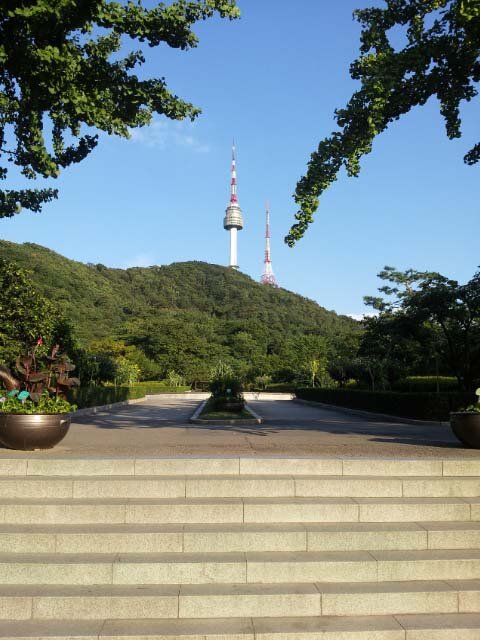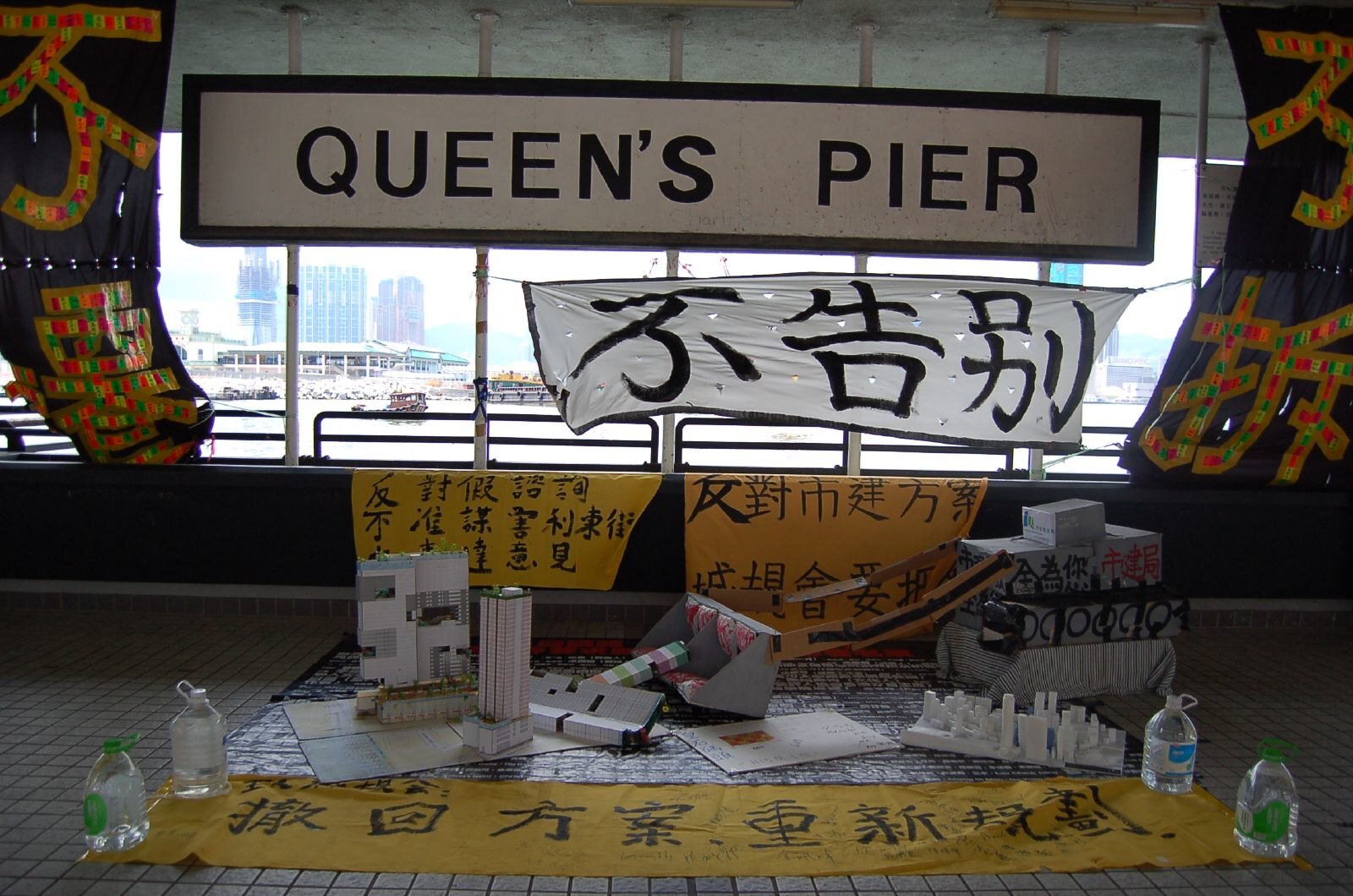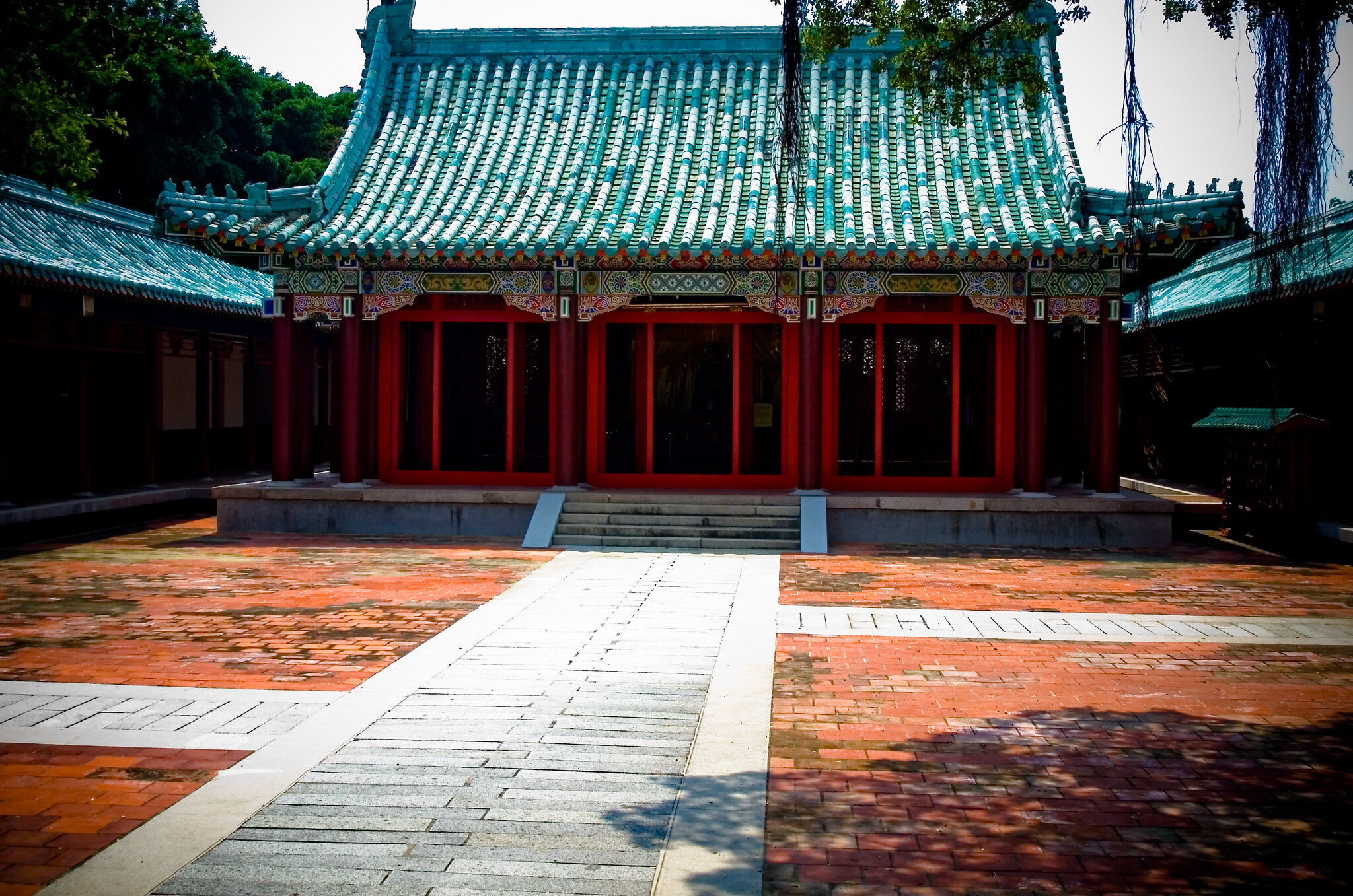Touring Shinto Shrines in Seoul
Emergence of Contestation: 2017
The "dark history" tour along a route on South Mountain in central Seoul aims to showcase the disgraceful history of Japanese colonial rule over Korea and the associated hardships by placing the remains of the Shinto Shrines located along the route in their historical context. Few of the Shrines have been re-purposed as sites of memorialisation, most remain unmarked (aside from in the tour guide materials), and reflect a disconnect in the awareness of Seoul's inhabitants between the spaces in the city they live in and their history.
The Memory and Legacy of shinto Shrine Sites in Seoul: The Geography of Colonial Religious Topoi - John G. Grisafi
Taiwan Jingu
Emergence of Contestation: 1901
Taiwan's general protector shrine, Taiwan Jinja, was established six years after Taiwan came under Japanese control. The three Pioneer Kami were enshrined in the first seat of the shrine, while a second seat enshrined Prince Kitashirakawa-no-miya Yoshihisa, who had died in Tainan in 1895 of malaria, after leading a successful pacification campaign against the remaining Qing loyalists in Taiwan. Like others in Taiwan, the shrine itself was handed over to the Republic of China after 1945, but remained largely unaltered until the 1970s. Then, as part of a broader policy of removing the traces of Japanese colonization and fostering patriotism, the shrine was razed and replaced with the towering Taipei Grand Hotel in 1973, which showcased northern Chinese (as opposed to southern Chinese or Taiwanese) architecture.
Desecration or Veneration: The Legacy of Shinto Shrines at the Borders of Imperial Japan - Karli Shimizu
Queen's Pier
Emergence of Contestation: 2007
The Queen's Pier in Hong Kong can function as a case study of the degree to which (formerly) colonial spaces continue to shape people's relationships to their colonial past and their own identitities even in the post-colonial period, through their spatial design intertwined with colonial education which generate lasting control systems impacting both body and mind.
Tracing the inveterate (post-)colonial controls: Queen's Pier in Hong Kong and the 'Cape No. 7' in Hengchun, Taiwan - Liza Wing Man Kam
Puppet Emperor Palace Museum
Emergence of Contestation: 1984
The Puppet Emperor Palace, dedicated to China's emperor Puyi, is at present designed to serve as a "site of memory" for the emperor's life journey from the throne to becoming an ordinary citizen of the newly formed Chinese state, as well as a symbol of China's successfull wartime struggle against the Japanese rule (specifically Japan's puppet government in Manchukuo). However, the site itself did not serve as the stage for most of Puyi's conversion, nor did it figure prominently in the Chinese resistance, which seemingly somewhat undermines its claim to the "site of memory" title. A consideration of the actual history of active Japanese governance associated with the site (as opposed to the "victim narrative" carefully constructed by the CCP) could restore this title to the museum, but would require a departure from the official Party narrative aimed at centering national legitimacy.
Beyond a "Site of Memory": The Puppet Emperor Palace Museum - Emily Matson
Memorial Tours to Palau
Emergence of Contestation: 1968
In 1968, Hiroshi Funasaka (舩坂弘1920-2006), who survived the Battle of Angaur, organised one of the earliest non-governmental tours to Palau to hold memorial services and build war monuments. Subsequently, veterans, bereaved families, and former Japanese immigrants joined such tours to Palau. Numerous momuments monuments were erected across Palau’s islands, while the tours were presented as national efforts to foster memories of the war in both Japan and Palau, despite an absence of Palaun involvement.
Negotiating War Memories at the Edge of the Former Japanese Empire: Two Japanese Veterans' Projects in Palau, Micronesia - Shingo Iitaka
Mimizuka (Ear Mound)
Emergence of Contestation: 1597
The Mimizuka memorial can serve as an example of a transformative mnemonic site, where meaning and memory of conflict is continuously reshaped through time. The representations of the monument and the collective memories associated with it shift between communities, generating narratives ranging from reproach to remembrance, and even reconciliation, all the while fueling discussion on how memorialisation is handled in today's society.
Kyoto's Mimizuka: Transformation and Contestation Across Four Centuries - Daniel Milne
Kuskus Shrine
Emergence of Contestation: 1939
Kuskus Jinja (高士神社), a shrine in the indigenous area of Mudan, practices veneration using Shinto ritual. Built in 1939, indigenous villagers going off to war promised to meet again in spirit at this shrine. The shrine's building was destroyed in 1946 by a typhoon. Although local villagers had long wanted to rebuild the shrine, it wasn't was not until 2015 that the shrine was rebuilt, with financial help from Japanese donors. The newly built Gaoshi shrine venerates the village's war dead, rather than Amaterasu. It is not associated with any Shinto organisations in Japan, but the rites are conducted by a Shinto priest from Japan who is training a local man as his successor. Although the ritual is conducted in a Shinto-style, indigenous and Chinese customs are incorporated into the ceremony,and the shrine is an adaptation of Shinto rites to meet the needs of the community to memorialise their war dead.
Desecration or Veneration: The Legacy of Shinto Shrines at the Borders of Imperial Japan - Karli Shimizu
Kaizan Jingu
Emergence of Contestation: 1896
Kaizan Jinja was established by renaming a seventeenth century site dedicated to the veneration of Koxinga, the Japan-born Ming loyalist and merchant-pirate who drove the Dutch from Taiwan and established his own short-lived kingdom. By request of the new Japanese governor of Tainan, the Taiwan Governor-General swiftly recognised the site as an official Shinto shrine, but retaining the southern Chinese-style buildings. In the late 1930s, a new Japanese-style shrine was built at the site, but the old building was preserved within the shrine garden. The ROC government tore down both the Japanese shrine and the old Chinese building. In its place, a new shrine now part of the Koxinga Museum, was built in a northern Chinese-style of architecture. The koma inu statues and stone torii gate were kept, although the gate's top bar was knocked off and the symbol of the ROC was added to it.
Desecration or Veneration: The Legacy of Shinto Shrines at the Borders of Imperial Japan - Karli Shimizu
Hengchun
Emergence of Contestation: 1940s
Hengchun in Taiwan can function as a case study of the degree to which (formerly) colonial spaces continue to shape people's relationships to their colonial past and their own identitities even in the post-colonial period, through their spatial design intertwined with colonial education which generate lasting control systems impacting both body and mind.
Tracing the inveterate (post-)colonial controls: Queen's Pier in Hong Kong and the 'Cape No. 7' in Hengchun, Taiwan - Liza Wing Man Kam
Angaur State Nature Park Project
Emergence of Contestation: 2001
The 2001 Angaur State Nature Park Project was organised by a veteran of the battle which had taken place there, Yōji Kurata (倉田洋二1927-2019), in order to stave off a fading of the memories of the historic events which had taken place there. He launched the Angaur State Nature Park Project, an ecotourism package that incorporated war site tours in order to appeal to Japanese visitors without direct connections with the battle.While the project was ultimately unsuccessful, the project sought to invorporate locals within the material commemoration of events two generations ago.
Negotiating War Memories at the Edge of the Former Japanese Empire: Two Japanese Veterans' Projects in Palau, Micronesia - Shingo Iitaka
Ainu Remains
Emergence of Contestation: 1869
The Ainu human remains stolen from Hokkaido gravesites for scientific purposes in the period of the Japanese colonisation of Hokkaido are presently still housed in museum collections across the globe, provoking protest from Ainu activists who demand their return. The remains themselves have become sites of memory through which Japanese colonial amnesia is challenged.
Stolen Ainu Remains as Sites of Memory - Michael Roellinghoff
Comfort Women Statue (Seoul)
Emergence of Contestation: 1991, 2011
The Statue of Peace serves as a memorial to young Korean women who became victims of the Japanese wartime military prostitution system. The physical placement of the Statue is Seoul opposite the Japanese embassy was highly symbolic of the victims' waiting for a full and formal apology. However, its reach and the political pressure it could exert were amplified through digital reproduction, which ultimately allowed for a global debate to be kindled. Understanding the Statue in the context of visual politics allows for understanding its rise as a symbol of resistance.
Visualising Korea: The Politics of the Statue of Peace - David Chapman
Meiji Shrine
Emergence of Contestation: 1912
The Meiji Shrine today is a popular tourist destination, and a site for a wide variety of events and festivities. However, the Shrine also functions as a mnemonic site with various audiences, and is attached with a complex web of meanings, - at times seemingly contradictory, - from the veneration of the Meiji emperor to a symbol of postwar democratisation. The Shrine is a centre not only for religious life, but also for historical consciousness.
Forgetting War and Remembering Progress at the Meiji Shrine - Peter Zarrow
Hokkaido Jingu
Emergence of Contestation: 1869, 1895, 1945, 1949-1987
The Shinto shrines built over time along the expanding Imperial Japanese border carried different associations in different locations across varying points in time. While the shrines in Hokkaido retained a religious association even after the war and were linked to the pioneer narrative, in colonial Taiwan the shrines were primarily locations of patriotic worship of the dead, and, as they became set as secular after the war, they transformed into symbols of a multicultural Taiwan.
Desecration or Veneration: The Legacy of Shinto Shrines at the Borders of Imperial Japan - Karli Shimizu




























